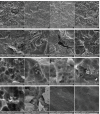Physicochemical Changes of Contaminated Titanium Discs Treated With Erbium-Doped Yttrium Aluminum Garnet (Er:YAG) Laser Irradiation or Air-Flow Abrasion: An In Vitro Study
- PMID: 35155152
- PMCID: PMC8837866
- DOI: 10.34172/jlms.2021.67
Physicochemical Changes of Contaminated Titanium Discs Treated With Erbium-Doped Yttrium Aluminum Garnet (Er:YAG) Laser Irradiation or Air-Flow Abrasion: An In Vitro Study
Abstract
Introduction: Peri-implantitis is a common complication of dental implant treatment. A cause-and-effect relationship has been previously documented between microbial plaque and peri-implantitis and implant failure. A difference has been reported in the disinfection efficacy of erbium laser irradiation and air-flow abrasion for contaminated titanium surfaces. Also, the surface changes caused by lasers and air-flow abrasion have not been well studied. Thus, the purpose of this study was to compare the surface changes of contaminated titanium discs following decontamination by erbium-doped yttrium aluminum garnet (Er:YAG) laser irradiation and air-flow abrasion. Methods: Twenty-eight intact, sandblasted, and acid-etched (SLA) titanium discs were used. Twenty-four titanium discs were contaminated with Escherichia coli. Then, they were decontaminated by using Er:YAG laser irradiation and air-flow abrasion. Four discs remained intact. The mean and standard deviation of the contact angle and the weight percentage of aluminum, titanium, oxygen, carbon, phosphorus, and calcium were measured. Qualitative changes in surface topography of titanium discs were assessed by scanning electron microscopy (SEM). Results: The mean weight percentage of carbon in the air-flow abrasion group (4.98%) experienced a significant reduction compared with the contaminated (positive control) group (P=0.035). The contact angles were 46.54° and 38.67° in the laser and air-flow abrasion groups respectively, which were significantly lower than the value in the positive control group (75.15°) (P ≤0.001). SEM micrographs showed no significant change in the surface area in either technique. Conclusion: Air-flow abrasion was more successful in improving the surface characteristics of titanium discs with no alteration in surface topography or elements, compared with Er:YAG laser irradiation. Further studies regarding the safety of the Er:YAG laser for the decontamination of titanium surfaces are recommended.
Keywords: Decontamination; Energy Dispersive X-ray Spectroscopy; Lasers; Peri-Implantitis; SEM; Wettability.
Copyright © 2021 J Lasers Med Sci.
Similar articles
-
A comparison of human dental pulp stem cell activity cultured on sandblasted titanium discs decontaminated with Er:YAG laser and air-powder abrasion: an in vitro study.Lasers Med Sci. 2022 Oct;37(8):3259-3268. doi: 10.1007/s10103-022-03615-y. Epub 2022 Jul 30. Lasers Med Sci. 2022. PMID: 35907129
-
Efficacy of Er:YAG laser irradiation for decontamination and its effect on biocompatibility of different titanium surfaces.BMC Oral Health. 2021 Dec 18;21(1):649. doi: 10.1186/s12903-021-02006-z. BMC Oral Health. 2021. PMID: 34922525 Free PMC article.
-
Surface alterations of polished and sandblasted and acid-etched titanium implants after Er:YAG, carbon dioxide, and diode laser irradiation.Int J Oral Maxillofac Implants. 2010 Jan-Feb;25(1):104-11. Int J Oral Maxillofac Implants. 2010. PMID: 20209192
-
Efficacy of Decontamination Methods for Biofilm Removal from Dental Implant Surfaces and Reosseointegration: An AAP/AO Systematic Review on Peri-implant Diseases and Conditions.Int J Oral Maxillofac Implants. 2025 Jun 6;(4):91-160. Int J Oral Maxillofac Implants. 2025. PMID: 40476898
-
Erbium-Doped Yttrium Aluminium Garnet (Er:YAG) Lasers in the Treatment of Peri-Implantitis.Cureus. 2025 Jan 31;17(1):e78279. doi: 10.7759/cureus.78279. eCollection 2025 Jan. Cureus. 2025. PMID: 39897297 Free PMC article. Review.
Cited by
-
Microbiological and Imaging-Based Evaluations of Photodynamic Therapy Combined with Er:YAG Laser Therapy in the In Vitro Decontamination of Titanium and Zirconia Surfaces.Microorganisms. 2024 Jun 30;12(7):1345. doi: 10.3390/microorganisms12071345. Microorganisms. 2024. PMID: 39065113 Free PMC article.
-
Implant Surface Decontamination Methods That Can Impact Implant Wettability.Materials (Basel). 2024 Dec 20;17(24):6249. doi: 10.3390/ma17246249. Materials (Basel). 2024. PMID: 39769848 Free PMC article. Review.
-
Impact of Er,Cr:YSGG Laser, Sandblast, and Acid Etching Surface Modification on Surface Topography of Biodental Titanium Implants.J Lasers Med Sci. 2023 Sep 30;14:e38. doi: 10.34172/jlms.2023.38. eCollection 2023. J Lasers Med Sci. 2023. PMID: 38028874 Free PMC article.
-
Antibacterial and Bactericidal Effects of the Er: YAG Laser on Oral Bacteria: A Systematic Review of Microbiological Evidence.J Funct Biomater. 2025 Jun 3;16(6):209. doi: 10.3390/jfb16060209. J Funct Biomater. 2025. PMID: 40558896 Free PMC article. Review.
References
-
- Mombelli A. Etiology, diagnosis, and treatment considerations in Peri-Implantitis. Curr opin Periodontol. 1997;4:127–36. - PubMed
LinkOut - more resources
Full Text Sources



